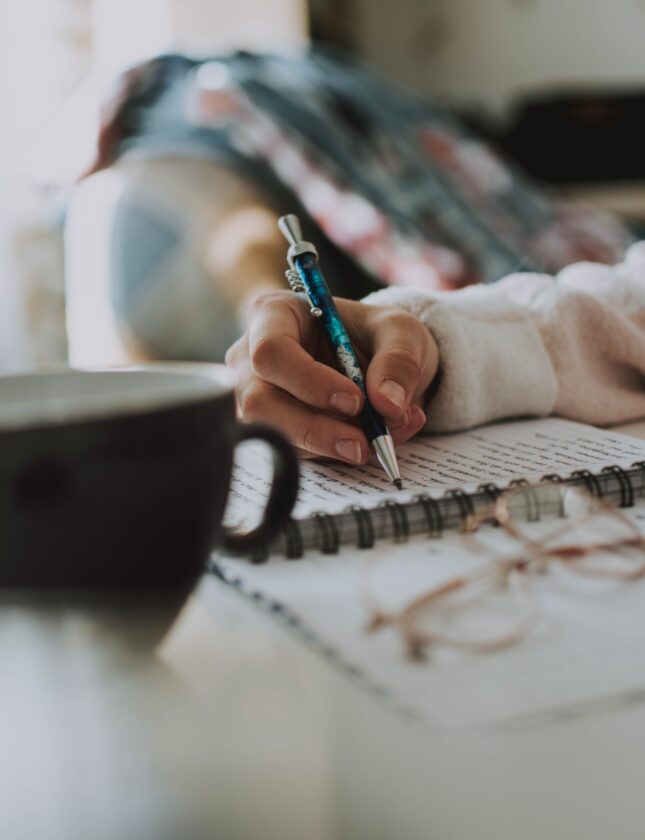Journaling: It works for a LOT of people, but if you're like us, you may wonder how (or why) to get into it
Okay, guys, this is something I have seen work for SO MANY people. I have tried it in the past, but I have found it hard to add it to my practice and see results for myself — I know that it’s a really helpful tool and it works! Today, I wanted to share some helpful tips that I have found and researched to help me get into journaling. Hopefully, it also helps and inspires you to pick up this practice. Let me know if you try it and if these tips work for you!
Camila

Here are some tips and ideas on how to journal from the University of Rochester. Think of these as the beginners’ guide to having a journaling practice. We find that when we can understand why something is beneficial, then we have a much easier time adopting the new habit.
When you were a teenager, you might have kept a diary hidden under your mattress. It was a place to confess your struggles and fears without judgment or punishment. It likely felt good to get all of those thoughts and feelings out of your head and down on paper. The world seemed clearer.
You may have stopped using a diary once you reached adulthood. However, the concept and its benefits still apply. Now, it’s called journaling. It’s simply writing down your thoughts and feelings to understand them more clearly. And if you struggle with stress, depression, or anxiety, keeping a journal is a great idea. It can help you gain control of your emotions and improve your mental health.
One of the ways to deal with any overwhelming emotion is to find a healthy way to express yourself. This makes a journal a helpful tool in managing your mental health. Journaling can help you:
• Manage Anxiety
• Reduce stress
• Cope with depression
Journaling helps control your symptoms and improve your mood by:
• Helping you prioritize problems, fears, and concerns
• Tracking any symptoms day-to-day so that you can recognize triggers and learn ways to better control them
• Providing an opportunity for positive self-talk and identifying negative thoughts and behaviors
When you have a problem and are stressed, keeping a journal can help you identify what’s causing that stress or anxiety. Once you’ve identified your stressors, you can work on a plan to resolve the problems and reduce your stress.
HOW TO JOURNAL
Try these tips to help you get started with journaling:
• Try to write every day. Set aside a few minutes every day to write. This will help you to write in your journal regularly.
• Make it easy. Keep a pen and paper handy at all times. Then, when you want to write down your thoughts, you can. You can also keep a journal in a computer file.
• Write whatever feels right. Your journal doesn’t need to follow any certain structure. It’s your private place to discuss whatever you want. Let the words flow freely. Don’t worry about spelling mistakes or what other people might think.
• Use your journal as you see fit. You don’t have to share your journal with anyone. If you do want to share some of your thoughts with trusted friends and loved ones, you could show them parts of your journal.

Another great resource that might be helpful is the one below, written by The Holistic Psychologist and How to Do Future Self Journaling. This can be a very powerful daily practice and is a more structured way to get yourself into daily journaling.
WHY DO FUTURE SELF JOURNALING?
Future self-journaling works because it creates conscious awareness of your behaviors and patterns. For many of us, this exercise is the first (and only time) we’ve done this.
I talk often about the subconscious. Subconscious means below awareness. It’s the mental software that was created in our childhood while our brain was in a theta hypnotic state. We needed this mental software to learn how to “be” in our world. As children, we had to quickly learn the language, social norms, how to communicate, and what was expected of us from our caregivers. We didn’t get to consciously choose what beliefs and behaviors we wanted to adopt.
They were chosen for us.
By age 7, we became conscious as our brain waves shifted. We continued to operate under this mental software, unaware of its existence.
We spend 95% of our time in the subconscious.
Every time we are doing something without being fully present, the subconscious is running. We run on autopilot. Think about your drive to work. Your mind may be thinking about what you’ll do that day at work or the fight you had with your partner last night. Yet, you are making all the right turns, breaking at red lights, and driving when you see the green light. The subconscious is at work. When you start paying attention, you’ll see just how often you are in this state.
To change our behavior, we have to become conscious of our subconscious behavior.
By being present and aware of our habit loops, we can start to shift them.
Future self-journaling is a tool that allows you to start becoming conscious. The more you use it, the more your consciousness will expand. It’s in this expanded consciousness state that you find the ultimate empowerment: choice in response.
How do I begin?
You begin on page 1 titled, “Self-Awareness.” This step is only done once for each habit you want to change or develop. You use this format to find the behavioral patterns that you want to change. Note: I do get messages from some people who can’t figure out what it is they want to change. This means you need to observe yourself before you can begin. If you don’t know what you want to change, start your day with this intention: “Today, I will notice behaviors that are holding me back from my highest potential.” Do this for 1-2 weeks. Write down (or enter into the notepad on your phone) the insights as you get them. Then, you can begin Step 1.
Step 1: Self Awareness
I will go through some examples below:
1. What behavior or pattern do I want to change? Focus on ONE.
“I want to stop becoming defensive in my day-to-day interactions”
2. Write affirmations or statements that will help you achieve this. Let these flow naturally. Do not overthink this:
“I can hear other perspectives.” “I am calm.” “I create space between my reactions.” “I am safe within my body.”
3. Write how you will be able to practice these new behaviors in daily life:
“I will practice observing the feelings and thoughts that come up rather than habitually reacting when interacting with my family.”
After you’ve finished Step 1, you don’t need to complete it again for at least 30 days or until you successfully see change. Then, you can start working on a new pattern. You will now go on to Step 2.

Step 2: I will go over the examples below:
My daily affirmation:
I am calm and peaceful. I can observe and not react.
Today I will focus on shifting my pattern of:
Habitually reacting to situations when facing an emotional trigger.
I am grateful for:
The opportunity to become a different version of myself. My pets, my family, the ability to create, and my favorite hiking trail.
The person I am becoming will experience more:
Joy, gratitude, abundance, and the ability to live in the present moment.
I have an opportunity to be my future self today when I:
Pause and listen rather than react.
When I think about who I am becoming I feel:
Confident, fulfilled, and proud of my healing.
Now that you have some examples, I will answer the most FAQs about future self-journaling.
“Do I need to do it every single day?”
Yes. This technique uses neuroplasticity. Our brains are plastic, which means through intentional acts, we can change the pathways in our brains. However, it takes consistent repetition to change these pathways. This practice only takes 5-8 minutes a day, which makes it easy to complete daily.
“What if I skip a day?”
No problem. If you skip a day, this is not an issue. Try to avoid assigning meaning to skip a day – i.e., (“I never finish what I start.” or “I’m lazy.”) Affirm to yourself that you will start again tomorrow. With each new habit, there are times when we will not show up. This is part of the path of learning to trust yourself – Today is one day, and tomorrow is a new opportunity.
“I have major resistance to journaling. I just can’t seem to start. Help.”
Resistance (mental chatter) is very normal. We typically have resistance to the things we need to do most for our evolution. The subconscious mind is very powerful, and when we attempt to break up its patterning, there will be a mental temper tantrum. You might feel anxious, scared, or even completely blocked off from doing it. Overcoming this is part of the process. Each time you choose to do the practice, even though your thoughts may be yelling to do otherwise, you are overcoming your mental resistance.
Don’t focus on it being “perfect” or if you are doing it “right.” If you can only do one question, just do one question. Build up each day. The act of completing a task you’ve committed to will be helpful in your healing.
“You show yourself journaling in the morning. Does that mean it’s the best/right time?”
If you follow me on Instagram, you’ve seen me journaling every single morning. This is the time that works best for me. It’s when I’m in the most creative and relaxed state. This is different for everyone. Some of you might want to do it before bed. Others might like to do it during a lunch break. The time is unimportant. It is the act of completing that is important. You might want to experiment with a few different times to see what works best. There is no “right” time to do future self-journaling.
“I am not having any breakthroughs. Does future self-journaling work for everyone?”
Future self-journaling can work for everyone. It’s the act of becoming consciously aware. However, it’s just a pathway to that awareness. You will start to be more aware of how you are thinking and behaving. The more you commit to the practice without judging the experience, the better your results will be. Expectations around a “breakthrough” might be blocking your awareness.
“I don’t want to keep the same pattern for 30 days, can I change it?”
You will get the most benefit if you stick to one pattern. It will allow you to focus your full attention on making that one change. You’ll want to try to stick it out for at least the entire 30 days to ensure that you are well on your way to saving this new habit as a new subconscious pattern.
“I’m skeptical about this working”
This is mental resistance, and it’s normal. Don’t focus on being skeptical. Focus your awareness on the questions and answer them with as much clarity as you can. As you go through the process, the skeptical resistance will fade.
Is it ok if I type the future self-journal?
Yes. But you will get more benefits by writing. Neuroscience shows us that writing connects differently in our brains.
I’m struggling with _______ what should I journal about?
You might come up against mental and emotional blocks during this process. Figuring out this process on your own is an important part of healing. Don’t worry about doing it “perfectly.” Focus on connecting to your own.
To learn more about Future Self Journaling click here.


















